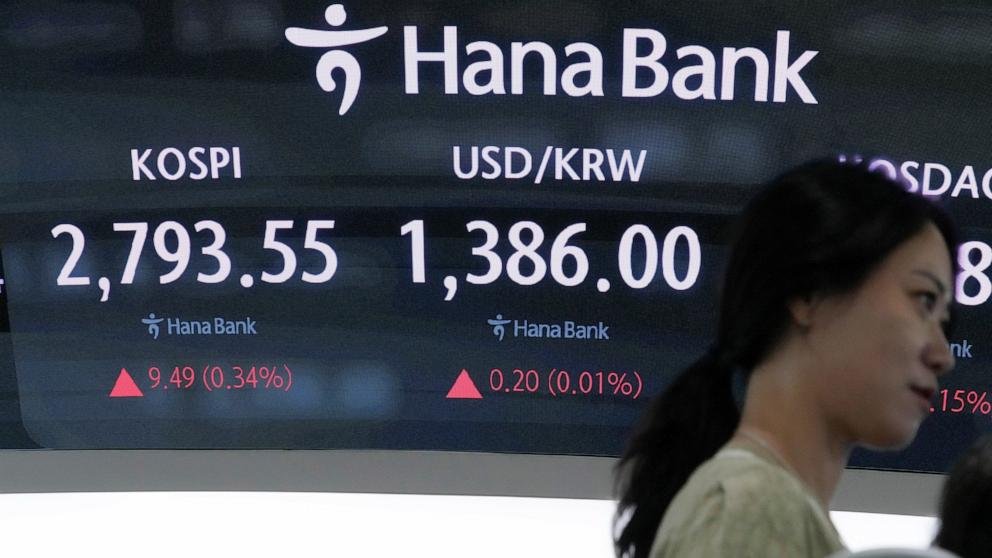Asian shares rose as traders looked ahead to a key report on inflation that could influence the Federal Reserve’s next interest rate moves.
TOKYO — Asian stocks rose on Friday as traders anticipated a key report on inflation that could influence the Federal Reserve’s next interest rate moves.
Japan’s benchmark Nikkei rose 0.4% to 39,583.08. Australia’s S&P/ASX 200 rose 0.1% to 7,768.00. South Korea’s KOSPI rose 0.1% to 2,787.51. Hong Kong’s Hang Seng index rose 0.3% to 17,767.93 and the Shanghai Composite index added 0.9% to 2,971.18.
In Japan, the government said industrial production rose to a better-than-expected 2.8% in May, while the unemployment rate was unchanged from the previous month at 2.6%.
The S&P 500 rose just 0.1% on Thursday, with the benchmark index hovering near the all-time high it hit last week.
The Nasdaq Composite Index rose 0.3%, just below its all-time high, while the Dow Jones Industrial Average closed up 0.1%.
Overall, the S&P 500 rose 4.97 points to 5,482.87, the Dow added 36.26 points to 39,164.06 and the Nasdaq added 53.53 points to close at 17,858.68.
Gains in retailers and communications services outweighed declines in consumer goods makers, financial stocks and the rest of the market. Amazon.com Inc. rose 2.2 percent and Meta Platforms Inc. added 1.3 percent.
Walgreens Boost Alliance Inc. plunged 22.2%, the biggest drop in the S&P 500 index, after the company reported weaker-than-expected earnings, cut its outlook and said it could close hundreds more stores over the next three years.
Jeans maker Levi Strauss & Co. saw its shares fall 15.4% after its latest quarterly sales and full-year profit outlook fell short of analysts’ expectations.
Spice maker McCormick Inc. rose 4.3 percent, the market’s biggest gainer, after beating analysts’ profit estimates.
Shares of chipmaker Micron Technology Inc. fell 7.1% after its latest outlook disappointed investors.
In the bond market, Treasury yields fell. The yield on the 10-year Treasury note, which influences interest rates on mortgages and other consumer loans, fell to 4.28% from Wednesday’s closing price of 4.33%. The yield on the two-year note fell to 4.71% from 4.75%.
Stocks have been lackluster this week ahead of Friday’s release of the next big inflation report from the government. The personal consumption expenditures index (PCE) is the Fed’s preferred inflation gauge.
In the report, economists expect inflation to ease modestly to 2.6% in May, following 2.7% in April, below the PCE peak of 7.1% in mid-2022. Other inflation measures, including the Consumer Price Index, have also eased significantly over the past two years.
The latest information on inflation could influence central banks’ decisions on when to start cutting interest rates, which are at their highest in more than two decades and have ripple effects around the world. Wall Street expects central banks to start cutting interest rates when they meet in September.
The U.S. economy expanded at a 1.4% annualized pace in January-March, according to the government’s latest update, a slight revision from a previous estimate of 1.3%. That would be the slowest quarterly growth rate since the spring of 2022.
A slowdown in consumer spending could help ease inflation further, but too much of a slowdown could deal a bigger blow to the economy. The Fed is trying to time its efforts to bring inflation back to its 2% target without slowing the economy enough to tip it into recession.
The S&P 500 is on track for its fourth straight week of gains. With one more trading day left this month, the index is up just under 4% in June and about 15% so far this year.
In energy trading, benchmark U.S. crude rose 47 cents to $82.21 a barrel, while the international standard Brent crude added 46 cents to $86.85 a barrel.
In currency trading, the U.S. dollar rose to 161.00 yen from 160.72 yen, and the euro fell to 1.0693 dollars from 1.0709 dollars.

